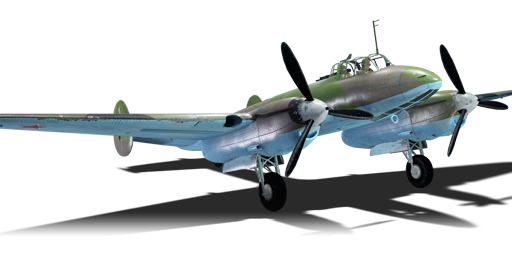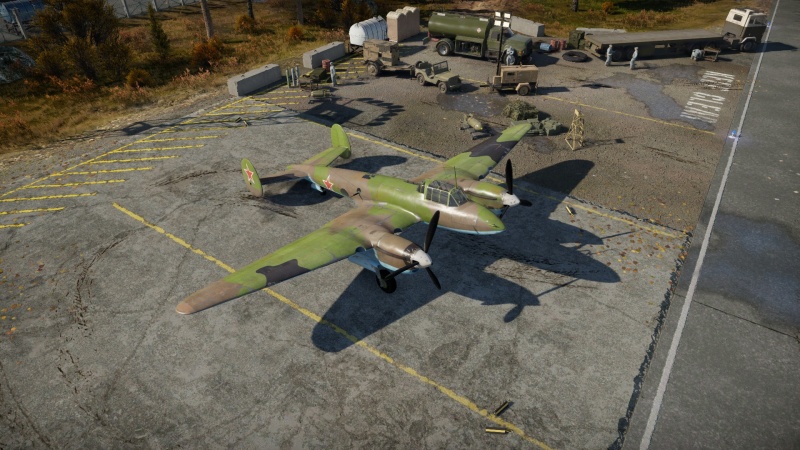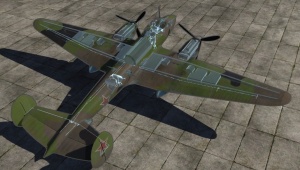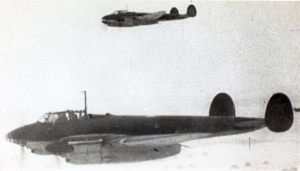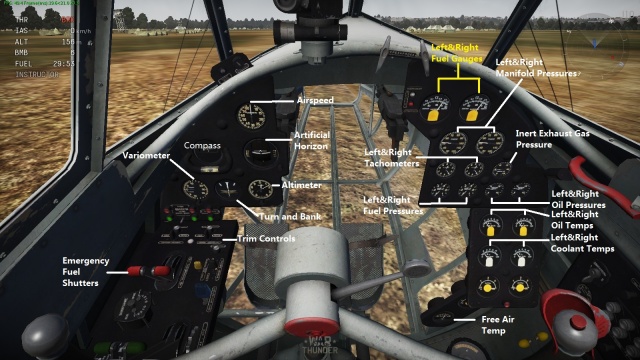Difference between revisions of "Pe-2-205"
(Updated format) |
m (→Details) |
||
| Line 80: | Line 80: | ||
|} | |} | ||
| − | {| class="wikitable" style="text-align:center" | + | {| class="wikitable" style="text-align:center" width="50%" |
|- | |- | ||
| − | ! colspan=" | + | ! colspan="7" | Limits |
|- | |- | ||
| − | ! rowspan="2" | | + | ! rowspan="2" | Wings (km/h) |
| − | ! rowspan="2" | Gear | + | ! rowspan="2" | Gear (km/h) |
| − | ! | + | ! colspan="3" | Flaps (km/h) |
! colspan="2" | Max Static G | ! colspan="2" | Max Static G | ||
|- | |- | ||
| − | ! + | + | ! Combat !! Take-off !! Landing !! + !! - |
| − | ! - | ||
|- | |- | ||
| − | | | + | | {{Specs|destruction|body}} || {{Specs|destruction|gear}} || 508 || 477 || 320 || ~11 || ~6 |
|- | |- | ||
|} | |} | ||
Revision as of 10:54, 18 February 2021
| This page is about the gift Russian dive bomber Pe-2-205. For other uses, see Pe-2 (Family). |
Contents
Description
The Pe-2-205 Peshka is a rank III gift Russian dive bomber with a battle rating of 3.7 (AB/RB/SB). This aircraft was in the game since the start of the Open Beta Test prior to Update 1.29. It was made available for purchase in the store as a Peshka starter kit since 28 September 2012 and was taken off the Gaijin store after the Clearance sale in November 2016. It has since become hidden from the store and is currently unavailable to players who want to purchase it.
The Pe-2 (or "Peshka", as it was nicknamed) is one of the fastest bombers in its battle rating. It relies on its speed and outstanding manoeuvrability (for a bomber) to evade interception. While its defensive armament is acceptable, it should only rely on its gunners as a last resort. The 12.7 mm UBT heavy machine guns covering the rear can be quite effective, but the waist 7.62 mm ShKAS machine guns are not very useful.
The Pe-2 is only capable of carrying up to 1,000 kg of bombs, and even then only externally, which will noticeably cut performance. However, it is also the only bomber in its battle rating that can equip rockets like the RS-132 and semi-armour piercing RBS-132. The RS-132 with the fuse set to air-burst can be surprisingly effective against bombers with good aim. The RBS-132 is more effective against tanks in Realistic Battles. It is also equipped with two fixed forward-firing machine guns (12.7 mm UB and 7.62 mm ShKAS), although these have relatively limited utility other than strafing light targets.
As a dive bomber, the aircraft is equipped with dive brakes to control the acceleration during dive attacks. However, the Pe-2 also has a level bombsight, which allows it to bomb from altitude with decent accuracy.
The Petlyakov Pe-2 is a versatile high-speed tactical level and dive bomber. It has very good performance and manoeuvrability for a twin-engine bomber, attained at the expense of the payload. It excels at surgical strikes against small targets like pillboxes and tanks. The Pe-2 can also be used as a level bomber against stationary targets, although the small payload makes it less efficient than heavier bombers like the Heinkel He 111 series.
General info
Flight performance
| Characteristics | |||||||
|---|---|---|---|---|---|---|---|
| Stock | |||||||
| Max Speed (km/h at 3,700 m) |
Max altitude (meters) |
Turn time (seconds) |
Rate of climb (meters/second) |
Take-off run (meters) | |||
| AB | RB | AB | RB | AB | RB | ||
| 507 | 493 | 8,800 | 28.4 | 29.8 | 10.6 | 10.5 | 326 |
| Upgraded | |||||||
| Max Speed (km/h at 3,700 m) |
Max altitude (meters) | Turn time (seconds) | Rate of climb (meters/second) |
Take-off run (meters) | |||
| AB | RB | AB | RB | AB | RB | ||
| 539 | 524 | 8,800 | 25.8 | 27.0 | 15.1 | 12.8 | 326 |
Details
| Features | ||||
|---|---|---|---|---|
| Combat flap | Take-off flap | Landing flap | Air brakes | Arrestor gear |
| ✓ | ✓ | ✓ | ✓ | X |
| Limits | ||||||
|---|---|---|---|---|---|---|
| Wings (km/h) | Gear (km/h) | Flaps (km/h) | Max Static G | |||
| Combat | Take-off | Landing | + | - | ||
| 740 | 450 | 508 | 477 | 320 | ~11 | ~6 |
| Optimal velocities | |||
|---|---|---|---|
| Ailerons (km/h) |
Rudder (km/h) |
Elevators (km/h) |
Radiator (km/h) |
| < 380 | < 380 | < 440 | > 250 |
| Compressor (RB/SB) | ||
|---|---|---|
| Setting 1 | ||
| Optimal altitude | 100% Engine power | WEP Engine power |
| 700 m | 2,520 hp | ?,??? hp |
| Setting 2 | ||
| Optimal altitude | 100% Engine power | WEP Engine power |
| 2,700 m | 2,360 hp | ?,??? hp |
Survivability and armour
- 13.5 mm Steel plate behind the pilot
- 8 mm Steel plate in front of the dorsal gunner
- 8 mm Steel plate in front of the ventral gunner
- Several fuel tanks located in wings near
Modifications and economy
Armaments
Offensive armament
The Pe-2-205 is armed with:
- 1 x 12.7 mm Berezin UB machine gun, nose mounted (150 rpg)
- 1 x 7.62 mm ShKAS machine gun, nose mounted (450 rpg)
Suspended armament
The Pe-2-205 can be outfitted with the following ordnance:
- 6 x 100 kg FAB-100sv bombs (600 kg total)
- 2 x 250 kg FAB-250sv bombs + 4 x 100 kg FAB-100sv bombs (900 kg total)
- 4 x 250 kg FAB-250sv bombs (1,000 kg total)
- 2 x 500 kg FAB-500sv bombs (1,000 kg total)
- 10 x RS-132 rockets
- 10 x RBS-132 rockets
Defensive armament
The Pe-2-205 is defended by:
- 1 x 12.7 mm Berezin UB machine gun, dorsal turret (200 rpg)
- 1 x 12.7 mm Berezin UB Machine Gun, ventral Turret (200 rpg)
- 1 x 7.62 mm ShKAS machine gun, 2 x beam turret (225 rpg = 450 total)
Usage in battles
The Peshka offers many options in combat depending on the loadout. As a dive bomber, the Pe-2 can use its high diving speed to quickly strike at some targets from high altitude, building up enough speed in the dive to evade interception and return to friendly airspace. The Pe-2 can also perform as a level bomber if there are too many enemies at low altitude to safely dive-bomb, although the small payload is not efficient against bases. The 500 kg FAB-500 bomb is the most effective bomb against bases and pillboxes from high altitude. Finally, the Pe-2 can equip RS-132 rockets with air-burst fuses and utilize them against enemy bombers, thanks to its high performance and bomber altitude spawn. The RBS-132 rockets are most effective in Ground Realistic Battles due to the better-modelled damage mechanics against tanks there.
As with any bomber, the defensive guns on the Pe-2 are a last resort, and should not be relied upon to consistently fend off enemies. Its high performance and manoeuvrability are its best defence.
Manual Engine Control
| MEC elements | ||||||
|---|---|---|---|---|---|---|
| Mixer | Pitch | Radiator | Supercharger | Turbocharger | ||
| Oil | Water | Type | ||||
| Controllable | Not controllable | Not controllable | Not controllable | Separate | Not controllable | Not controllable |
Pros and cons
Pros:
- Fixed forward-firing machine guns
- Outstanding performance and manoeuvrability (especially roll rate) for a bomber
- Can equip rockets
- Has a bombsight and dive brakes, allowing it to act as a level or dive bomber
Cons:
- Machine guns are insufficient for any ground target heavier than an armoured car
- Large fuel tank in the midsection makes it vulnerable to fires
- Small internal payload, and must carry the heaviest payloads externally
- Defensive armament is average at best
History
Originally, the Petlyakov Pe-2 was not supposed to be a bomber at all. Its direct predecessor, designated VI-100, was designed by a prison design bureau team led by Vladimir Petlyakov as a high-altitude escort fighter. The VI-100 was very modern for its time, featuring a pressurized two-seat cockpit, electrically actuated systems and all-metal construction, and was powered by two supercharged Klimov M-105 V-12 inline engines producing 1100 horsepower each. The prototype was completed in 1939 and during its first test flight on 7th May 1939, it reached a top speed of 627.6 kph (390 mph) – an astounding performance for its time. The results of flight tests were so promising that the VI-100 was ordered into production.
However, Germany launched the "Blitzkrieg" campaign in September 1939. Aside from their revolutionary usage of tanks, the campaign in Poland featured notable usage of Ju 87 dive bombers and showed their potential. Consequently, the Soviet authorities ordered the VI-100 to be redesigned as a dive bomber. Pressurization equipment and engine superchargers were removed, dive brakes were installed under the wings and the bombardier position was added to the nose of the aircraft(raising the number of crew members to three). A ventral bomb bay was added along with the two smaller bomb positions located at the rear of engine nacelles. Two rear-facing turrets, each armed by a single ShKAS machine gun, were installed to dorsal and ventral positions. Resulting aircraft, able to carry up to 1600 kg / 3520 lbs of bombs, was designated PB-100. The first prototype flew on 15th December 1940 and its performance (top speed of 540.7 kph/336 mph) was so good that Vladimir Petlyakov was released and the aircraft was named after him, thus receiving the designation Petlyakov Pe-2. The bomber was then rushed into serial production and deliveries to combat units began in the spring of 1941. The deliveries were, however, slow and by the time of the German invasion in June 1941, only about 458 Pe-2's were delivered.
The Pe-2, nicknamed Peshka ("Pawn") by its crews, quickly proved itself to be an effective dive bomber and together with the Ilyushin Il-2 Sturmovik attacker, it became the most important offensive weapon of the Soviet Army Air Force. The bomber was fast and agile enough to be an elusive target for German fighters and also proved its versatility – it was used for reconnaissance and artillery spotting and also became the basis for the Pe-3 heavy fighter. Losses were heavy, however. Crews often complained about a lack of armour protection for the cockpit and fuel tanks as well as poor defensive armament and unreliable dive brakes, which sometimes failed to retract and allowed top speeds of only around 300 kph (186.4 mph), making the fast bomber easy prey.
In-game description
"By the summer of 1943, due to growing production volume and a general decrease in quality, the basic performance characteristics of production bombers had degraded to an intolerable level. The Factory No. 22 designers were tasked with drastically improving the quality of the bombers produced. The new chief designer, V. M. Myasishchev, was in charge of this work.
The Factory No. 22 designers, together with the researchers of the Central Aerohydrodynamic Institute (TsAGI), proposed a number of improvements for the Pe-2 design that were implemented in production in August 1943, beginning with series 205. Improvements were made to the flaps, cowls, and access doors, pressurization of the whole aircraft was ensured, the shape of the cooler ducts was altered, and carburettor inlet ducts with improved aerodynamics were installed. Brake cover fairings and a new single-blade compensator (with an increased area) for the VUB-1 turret were also installed. The radio antenna mast, together with the airspeed tube, was removed to the front arch of the cockpit canopy, and the junction of the canopy and the VUB-1 turret was improved. Some planes had individual exhaust pipes installed instead of the previous general exhaust manifolds.
Beginning with series 211, the beams of external bomb racks were moved into the wings, and beginning with series 249, it was decided that the oil should be diluted with gasoline in the winter. From series 265 on, the RSB-bis radio set was replaced with an RSB-3bis, and the general antenna-feeder system was improved, drastically increasing radio coverage. Series 275 saw yet another reinforcement of the Pe-2's rear defense: a DAG-10 grenade launcher was installed, with 10 AG-2 aerial grenades. The grenades were housed in the radio operator/gunner's cockpit in two clusters (five in each). A grenade launched from the aircraft would initially reduce speed (with a small parachute) and then, after a delay of 3 to 5 seconds, explode in the path of a pursuing fighter. The grenade launcher gave the gunner a chance to stop German fighters from comfortably attacking the Pe-2 from their favorite position, the rear.
Crews noted the bomber's high maneuverability and survivability, the good field of view from the cockpit, and good stability during dives. At the same time, though, it was noted that the aircraft was rather difficult to pilot, especially when taking off and landing."
Media
- Skins
- Images
- Videos
See also
- Related development
- Aircraft of comparable role, configuration and era
External links
| V.M. Petlyakov Design Bureau (Опытное конструкторское бюро Петлякова) | |
|---|---|
| Fighters | Pe-3 (e) · Pe-3 · Pe-3bis |
| Bombers | Pe-2-1 · Pe-2-31 · Pe-2-83 · Pe-2-110 · Pe-2-205 · Pe-2-359 · Pe-8 |
| USSR bombers | |
|---|---|
| SB and Ar | SB 2M-100 · SB 2M-103 · SB 2M-103 MV-3 · SB 2M-103U · SB 2M-103U MV-3 · SB 2M-105 · Ar-2 |
| Yer-2 (petrol) | Yer-2 (M-105) · Yer-2 (M-105) TAT · Yer-2 (M-105R) TAT · Yer-2 (M-105R) LU |
| Yer-2 (diesel) | Yer-2 (ACh-30B) (e) · Yer-2 (ACh-30B) (l) |
| Tu | Tu-2 · Tu-2S · Tu-2S-44 · Tu-2S-59 · Tu-4 |
| Pe | Pe-2-1 · Pe-2-31 · Pe-2-83 · Pe-2-110 · Pe-2-205 · Pe-2-359 · Pe-8 |
| IL | DB-3B · IL-4 |
| Po | Po-2 · Po-2M |
| Other | MBR-2-M-34 · TB-3M-17-32 · Yak-4 · Be-6 |
| Lend-Lease | ▂PBY-5A Catalina · ▂Hampden TB Mk I · ▂A-20G-30 · ▂B-25J-30 |
| USSR premium aircraft | |
|---|---|
| Fighters | Krasnolutsky's I-15bis · I-16 type 28 · Zhukovsky's I-153-M62 · I-153P · I-180S · I-301 · ITP (M-1) |
| LaGG-3-4 · LaGG-3-23 · LaGG-3-34 · Dolgushin's La-7 · La-11 | |
| Eremin's Yak-3(e) · Yak-3 (VK-107) · Yak-3T · Golovachev's Yak-9M | |
| ▂P-39K-1 · ▂Pokryshkin's P-39N-0 · ▂P-39Q-15 · ▂P-40E-1 · ▂P-47D-27 · ▂P-63A-5 · ▂P-63A-10 · ▂P-63C-5 | |
| ▂Hurricane Mk IIB · ▂Spitfire Mk IXc · ▂Fw 190 D-9 | |
| Twin-engine fighters | I-29 |
| Jet fighters | Su-11 · MiG-15bis ISh · MiG-17AS · MiG-21S (R-13-300) · MiG-23ML |
| Strike aircraft | IL-2M "Avenger" · IL-2 M-82 · IL-8 (1944) · Su-6 · Tandem MAI · TIS MA · Su-8 · Tu-1 |
| Yak-38 · Su-7BMK · Su-25K · Su-39 | |
| Bombers | Po-2M · Be-6 · MBR-2-M-34 · Pe-2-205 · TB-3M-17-32 |
| ▂PBY-5A Catalina · ▂Hampden TB Mk I · ▂A-20G-30 · ▂B-25J-30 | |


